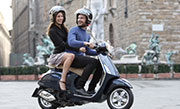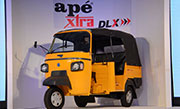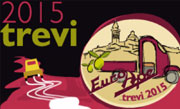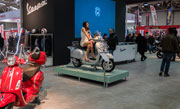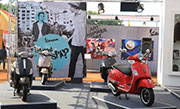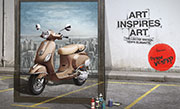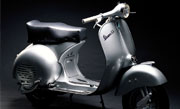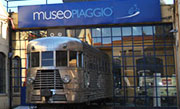Product
A FLOWERING OF VESPAS

VESPA PRIMAVERA INTERPRETS THE YOUNGEST AND MOST DYNAMIC SPIRIT OF THE MOST POPULAR SCOOTER IN THE WORLD. THE RANGE EVOLVE WITH THE INTRODUCTION OF ABS FOR THE 125 AND 150 ENGINE CAPACITY MODELS, CONFIRMING THE ATTENTION TO SAFETY AND THE CONSTANT TECHNOLOGICAL EVOLUTION. AND THERE IS ALSO THE NEW PRIMAVERA TOURING SPECIAL SERIES. THE CHOICE IS YOURS!
VESPA PRIMAVERA 125 AND 150 ABS
With the introduction of the ABS, Vespa confirms its cutting-edge technology which has always marked its history and makes it one of the most modern, advanced and safe vehicles on the road today Vespa Primavera is also available with the ABS braking system for the 125 and 150 models, the so-called “small body” vehicles. The locking up of the front wheel during intense braking or due to slippery asphalt is generally the most significant hazard for motorbike and scooter riders and passengers. The adoption of the ABS antilock braking system is triggered precisely to prevent this danger, making the ride pleasant and entirely safe.The front wheel on Vespa Primavera ABS has a speed detection system – a sensor and a tone wheel – which instantaneously measures its speed and deceleration compared to that of the scooter. The sensor dialogues with an electro hydraulic control unit, which activates the ABS system if the wheel decelerates abruptly, preventing locking and the consequent loss of control over the vehicle, thereby guaranteeing stability and efficient braking even on low friction coefficient surfaces. This sophisticated safety system, developed specifically for the Vespa “small bodies”, can also boast being lightweight, leaving the vehicle's kerb weight virtually unchanged in true Vespa tradition as one of the lightest scooters in the world. The new ABS system contributes to raising the already high safety level that the new Vespa Primavera and Vespa Sprint guarantee. The painstaking care taken in designing the various components has resulted in previously unseen levels of rigidity, but without compromising the weight of the structure. The safety and riding pleasure advantages are tangible, where riders will discover a Vespa with dynamic qualities and exceptional stability and handling. Vespa Primavera has also introduced a new type of front suspension, which provides a completely redesigned system capable of cutting sliding friction in half, increasing riding comfort and the ability to absorb bumps in the road. The wheel rim sizes also help provide maximum road safety.
NEW VESPA PRIMAVERA TOURING
Vespa Primavera is enriched by a new special range of Touring with accessories and aesthetic features inspired to travelling that Vespa has always embodied throughout its lengthy history. Vespa Primavera Touring, as the other Vespa models in this special outfitting, is enriched by a front and rear luggage rack both of which chromed that, as testimonial to the most classic Vespa iconography, greatly increase load carrying capacity and prepare the world's most popular scooter to take on any adventure packed journey. Touring's outfitting also includes a brown saddle matched with the new Silk Grey tint, elegant top fairing and a dedicated nameplate. The Vespa Primavera Touring series in available with Primavera engine capacity throughout the range, which are 50 2-stroke, 50 4-stroke 4V, 125 4-stroke 3V and 150 4-stroke 3V.IT'S AN ALL-NEW VESPA
The Vespa story is one of continuous technical and style evolution that, right from the very first models, encouraged the on going development of the world's most famous and well-loved two-wheeler so it was always one step ahead of the social changes. The modifications from one model to the next were often minimal; sometimes they were more important, but never losing sight of the original idea that placed elegance, pioneering technology and enjoyable riding at the heart of the project.
During such a long, unique history, there have of course been real turning points marked by more definite renewal. Just a few milestones on the Vespa evolution path, that have influenced its course for generations.
It happened with the Vespa GS in 1955, when Vespa discovered a sporty spirit that could produce breath-taking performance. Those were the years of American Rock’n Roll, the years of a generation that wanted to run, and Vespa interpreted those dreams and needs to the letter. It happened in 1977, with the Vespa PX. From the ’70s on, the younger generations yearned to cross the borders and travel. They felt the need for a top-performing vehicle with a distinctly new style, more imposing and modern, suitable for a world racing towards social and technological revolution. The Vespa PX marked out that age, dictating the style of the various future Vespa families and becoming the most successful model (over three million were sold).
The Primavera steps forward as an important point of evolution in the Vespa story. During the design phase, every solution focused on increasing the level of comfort, safety and driving pleasure compared with the previous (and even recent) generations, continuing an evolution that, for almost 70 years and after more than 18 million vehicles sold over the five continents, makes Vespa the youngest and best-loved two-wheeler in the world.
EXQUISITE AND DYNAMIC STYLE
The Vespa Primavera inherits the exclusive, refined elegance of the Vespa 946 and maintains that formal spirit. But, despite adopting the special characteristics of the most prized Vespa of all time, it doesn't sacrifice the practicality and comfort of a Vespa for everyday use - the daily star of city journeys.
The Vespa Primavera uses the best technology of its time. Its design and development are greatly advanced compared with previous generations. The central part, with its distinguishing omega shape, improves the riding position and gives the most modern Vespa a clear style feature taken from the story of legendary models; it rises like a “backbone” up to the base of the handlebar. It's an elegant throwback to the “Vespini” of the ’60s and ‘70s, where the metal structure supporting the shield and steering equipment was left visible. The footrest is now narrower at the sides and, together with the reduced height of the saddle, allows riders of any height to easily rest their feet on the ground. A glance at the Primavera immediately brings to mind the most classic Vespa style; the Primavera adopts it with ease but, without indulging in over-easy vintage references, interprets it with an eye to the future. The tail is again pointed and tapered, just like on the first prototype that inspired the name "Vespa" because of its similarity to a wasp. The extended taillight also helps to give the body a streamlined appearance. The alternating convex and concave lines of the bodywork respect the most classic Vespa standards but, thanks to a painstaking study of the reflections generated on them by the light, they now express a definite modern feel. Soft, rounded forms blend with the tension of sharp lines that give the entire vehicle an extra touch of vitality. The turn indicators and LED daylight running lights are not excessively large, leaving space for the front shield; they are elegantly fitted flush with the bodywork, to avoid interfering with the clean lines of the Vespa Primavera.
The distribution of the handlebar coverings has been revolutionised compared with the most recent Vespa models, taking up the classic horizontal divide (typical of the most famous Vespas) once again. The handlebar commands for the main functions have been inserted in true “cuffs” which, thanks to the chrome-plating, seem to be separated from the rest (also from an aesthetic viewpoint) and explicitly echo that element which acted as a gear/clutch unit on the left side of the handlebar on the most classic models. The electronic part uses state-of-the-art technology but within the trapezoidal lines of the classic Vespa instruments. The front, circular headlight has a chrome-plated ring nut on the edge - one of the clearest stylistic elements of the first version of the Vespa Primavera, while the modern, elegant taillight uses LED technology. The design of the 11” alloy wheel rims is entirely new and, despite respecting the traditional number of five spokes, manages to reinterpret a classic Vespa element.
Following in the footsteps of the Vespa tradition, the flat, two-seat saddle is now more comfortable and practical, with the double stitching that distinguishes refined Italian leatherwork. The rear part is surrounded by the passenger grab handle made, of course, in the traditional and unmistakable chromium pipe.
The Primavera colours (MonteBianco, Blu Midnight, Rosso Dragon, Marrone Crete Senesi and Nero Vulcano) are also a throwback to the Vespa memory, playing with the two exclusive saddle colours to create refined new colour combinations that further enhance the new Primavera.
TECHNOLOGY: A REVOLUTIONARY PRIMAVERA
All-new, more rigid body: The steel sheet bodywork, that also acts as a support, is the element that makes the Vespa stand out from every other scooter in the world. The Vespa Primavera body is completely new, although it maintains a loyalty to a unique construction philosophy and consists of pressed, welded parts.The precise design has produced previously unseen levels of rigidity, but without compromising the weight of the structure. The new position of the battery (in the central side member of the footrest) has increased the capacity of the helmet compartment to 16.6 litres (from 14.3 in the previous Vespa), further facilitating access to the engine for maintenance work (just be raising the helmet compartment). A new engine mounting system reduces vibrations: The engine is mounted on the body with a system of 2-position arms (only one position on the previous version) and uses a stop with double rubber absorption damper. As a result, the rider feels a notable reduction in vibrations in the various contact points (saddle, knobs and footrest). New front suspension: Despite maintaining the classic Vespa single arm suspension, the new Primavera has a completely redesigned system for reducing slide friction. The shock absorber is now fixed to the aluminium support that connects it to the wheel via a hinged pin, whereas previously it was fixed with two screws. For the driver, this technical innovation means far less friction and so greater comfort.
NEW 3-VALVE ENGINES
The new crankshaft, with reduced button and bench capacity, the pivoted cam axle on bearings and the roller rockers have made a significant improvement in operating friction, all to the benefit of performance and fuel economy. The new bore and stroke values (respectively reduced and increased in relation to the previous 4-stroke engines) mean improved torque and acceleration response. In the search for the best performance/fuel consumption ratio, the 3 valve timing solution is the most effective because it improves intake, increasing engine efficiency compared to conventional 2 valve engines. The 3V distribution enables better fuel mixture loading movements in the cylinder; the combustion process is further refined by the new spark plug position, which simultaneously ensures improved cooling of the components in the head, as well as simplified maintenance.
The cooling system was the object of careful analysis, even through thermo fluid dynamic simulations, in order to further improve performance and thereby obtaining a significant reduction in mechanical noise and absorbed power. The electronic injection system on the Vespa Primavera is entirely new. An ultra-modern and technologically advanced unit designed by Piaggio specifically for this latest Vespa model.
The new free wheel electric starter, more quiet and efficient, goes perfectly with an engine so rich with technological content. Also, the automatic dry centrifugal clutch has been calibrated with the goal of maximizing performance and fuel economy at low speeds. The Primavera has a new CVT (purposely designed for the new Vespa) to reduce engine rotations when shifting up from a low gear to a high one. This reduces the gear change speed, improving consumption levels and comfort without compromising the excellent pick-up and acceleration that distinguish the long 4-stroke engine.
The 3V also has the important advantage of weighing less than its 2V predecessor. The extremely low fuel consumption figures (up to 64 km/l at an average speed of 50 km/h) and lengthy maintenance gaps (service every 10,000 km) mean very low running costs. The new Primavera is the youngest of the Vespa family; the true great grandchild of the legendary 50cc Vespini with which the first Primavera (from the 60's) shared the same dimensions and bodywork. The Vespa Primavera is also designed for youngsters, for those starting out with their first Vespa on the search for freedom. For these young Vespa enthusiasts, the new Primavera offers the choice of two engines, both 50cc: a fun, sparkling 2-stroke and a modern, advanced 4-stroke with 4-valve distribution.
The 2-stroke 50 cc engine in the Hi-Per2 series is intended for riders looking for more brilliant performance, perfect for getting around quickly in the city. The 4-stroke 50 cc engine boasts modern 4 valve timing that provides more lively acceleration: it is, in fact, the most powerful 4-stroke 50 cc engine on the market, with its 4.35 HP produced in a very linear way, along with excellent fuel economy and limited polluting emissions.
PRIMAVERA MEMORIES
The first Vespa Primavera emerged in 1968. This was the year that witnessed a new awareness amongst the younger generation, that suddenly wanted to yell for freedom. The year when every classic mould broke down, marking the history of western culture forever. From the universities of California to the squares of Paris, a new social group - that of young people - demanded a place in the front row of a fast-changing society.
Vespa Primavera made its first appearance in that tumult of ideas and fervour, becoming the star by making two wheels and an engine available to the changing world: it became the heroine of an unforgettable season. Nimble, innovative lines, sparkling performance, easy and fun to ride - Vespa Primavera was a breath of fresh air in a world hungry for change. It went on to become one of the most durable and best-loved models in the Vespa story.




